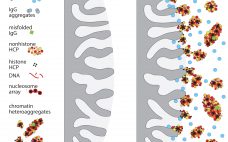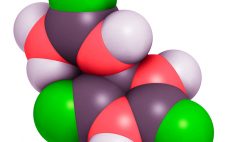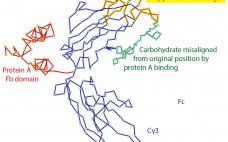CIMmultus ADC monoliths from BIA Separations are the first chromatography products in the field to exploit hydrogen bonding as the primary binding mechanism. These products bring a unique new selectivity to all purification challenges, but they are especially distinctive in their ability to retain large biomolecules more strongly than small ones. They enhance removal of fragments, aggregates, and viruses from proteins, and they enhance removal of proteins and other small contaminants from viruses and other very large biologics. H-Bond ADC…
Author Archives: Pete Gagnon
IgG Purification By Ultrafiltration: Time for Another Look
One of the early disappointments in development of immunoglobulin G (IgG) purification technology was ultrafiltration on membranes with 50–100 kDa cutoffs. Sodium dodecyl sulfate polyacrylamide gel electrophoresis (SDS-PAGE) showed that most host cell proteins were smaller than that. IgG was retained. Parallel concentration and buffer exchange could be performed going into a follow-on polishing step. These features made it an obvious candidate for initial capture, but it did not perform as hoped. Membrane fouling sabotaged its concentration–diafiltration potential, and prohibitive…
Recent Advances in Endotoxin Removal: An Upgrade to a Traditional Method and a New Adsorption Chemistry
Endotoxin contamination has been the bane of the bioprocessing industry since its inception. Endotoxins are everywhere: They are toxic and/or interfere with every type of therapeutic, diagnostic, and research product; they are indestructible within the limits of product tolerance; and they are difficult to remove (1–4). Beyond that, they interact with various biological species in ways that prevent accurate measurement (5, 6). Managing these issues has been a focus of the industry for at least half a century, yet it…
The Secret Life of Protein A
Affinity chromatography with protein A has become the foundation for purification of nearly every therapeutic IgG in commercial production. One of the features most responsible for its success has been its compelling simplicity. IgG binds. Contaminants do not. Load, wash, and elute pure IgG. In the real world, however, protein A does not elute pure IgG. It typically contains several hundred to a few thousand parts per million (ppm) contamination by host-cell proteins (HCPs) and other contaminants. Numerous studies demonstrate…
IgM Purification with Hydroxyapatite
Hydroxyapatite (HA) has a long and successful history in the field of antibody purification, and it has worked well for immunoglobulin M (IgM) monoclonal antibodies (MAbs) (1,2,3,4,5,6,7,8). Applications range from initial capture to intermediate purification to final polishing. HA is best known for its superior ability to reduce antibody aggregates, but it also supports excellent reduction of DNA, viruses, and endotoxins. As IgM MAbs exhibit increasing potential in the fields of cancer and infectious disease and in stem-cell therapies, HA’s…
Emerging Challenges to Protein A
Protein A affinity chromatography has been a target for replacement since its commercial debut, mainly because of its high acquisition cost. The technique became established despite the cost because it was born into an industrial culture that favored speed to market over manufacturing economy (1). Vendors have since strengthened protein A’s position with incremental but worthy improvements such as higher capacity, lower ligand leaching, and modest tolerance of NaOH. Collateral improvements in polishing technologies, such as the high throughput and…
Monoliths Open the Door to Key Growth Sectors
The enabling value of monoliths was strongly in evidence at the 4th International Monolith Symposium, held 29 May – 2 June in the Adriatic resort city of Portoroz, Slovenia. Forty-seven oral presentations and 34 posters highlighted important advances in vaccines, gene therapy, phage therapy for infectious disease, and monoclonal antibodies, as well as continuing advances in the performance of monoliths themselves. As these fields advance in parallel, it becomes increasingly apparent that monoliths offer industrial capabilities substantially beyond…
How to Choose an Industrial Cation Exchanger for IgG Purification
Cation-exchange chromatography is the third most used industrial method for antibody purification after anion-exchange and protein A affinity chromatography. It is most commonly used as an intermediate step but continues to attract attention as a capture method. This offers obvious cost and cleaning advantages over protein A but also imposes some sacrifices, all of which are discussed in a number of recent articles (1,2,3,4,5). Whichever application may be intended, end users seek a common set of performance characteristics.…
Minibodies and Multimodal Chromatography Methods
Small, genetically engineered immunological constructs are being developed industry-wide for a growing range of in vivo applications. Examples include Fab, F(ab’)2, single-chain (sc) Fv, bis-scFV, diabodies, minibodies, and single-domain antibodies (1). Their small size potentially gives them access to tissues that are poorly accessible by intact antibodies; rapid clearance from blood and nontargeted tissues; lower immunogenic response; and eye-drop, inhalant, or oral administration. We report here on purification of an affinity-matured, humanized, antiprostate stem-cell antigen (PSCA) minibody for…
The Emerging Generation of Chromatography Tools for Virus Purification
Chromatography media and methods have evolved continuously since their introduction a half century ago. Traditional methods use columns packed with porous particles. They still dominate chromatography applications in the field of virus purification, but the past 20 years have witnessed the ascendance of alternative supports, namely membranes and monoliths. These newer media exploit the familiar surface chemistries — ion exchange, hydrophobic interaction, and affinity — but they use unique architectures that offer compelling performance features. The Architecture of Chromatography Media…




